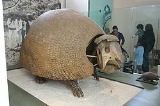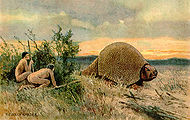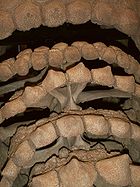
Glyptodontidae
Encyclopedia
Glyptodonts were large, more heavily armored relatives of extinct pampatheres
Pampatheriidae
Pampatheridae is an ancient family, now extinct, of large armadillo-like plantigrade armored xenarthrans. They are related to Glyptodontidae, an extinct family of much larger and more heavily armored xenarthrans, as well as to smaller extant armadillos...
and modern armadillo
Armadillo
Armadillos are New World placental mammals, known for having a leathery armor shell. Dasypodidae is the only surviving family in the order Cingulata, part of the superorder Xenarthra along with the anteaters and sloths. The word armadillo is Spanish for "little armored one"...
s.
They first evolved during the Miocene
Miocene
The Miocene is a geological epoch of the Neogene Period and extends from about . The Miocene was named by Sir Charles Lyell. Its name comes from the Greek words and and means "less recent" because it has 18% fewer modern sea invertebrates than the Pliocene. The Miocene follows the Oligocene...
in South America
South America
South America is a continent situated in the Western Hemisphere, mostly in the Southern Hemisphere, with a relatively small portion in the Northern Hemisphere. The continent is also considered a subcontinent of the Americas. It is bordered on the west by the Pacific Ocean and on the north and east...
, which remained their center of species diversity
Species diversity
Species diversity is an index that incorporates the number of species in an area and also their relative abundance. It is a more comprehensive value than species richness....
. For example, an Early Miocene glyptodont with many primitive features, when compared to other species, Parapropalaehoplophorus septentrionalis
Parapropalaehoplophorus
Parapropalaehoplophorus septentrionalis was a relatively small species of glyptodont, extinct relatives of the modern armadillo. The mammal, identified in 2007 from the fossilized remains of a specimen found in 2004, weighed approximately 200 pounds and had a shell covered by tiny circular bumps...
, was discovered at a now-elevated site in Chile
Chile
Chile ,officially the Republic of Chile , is a country in South America occupying a long, narrow coastal strip between the Andes mountains to the east and the Pacific Ocean to the west. It borders Peru to the north, Bolivia to the northeast, Argentina to the east, and the Drake Passage in the far...
and described in 2007. When the Panama
Panama
Panama , officially the Republic of Panama , is the southernmost country of Central America. Situated on the isthmus connecting North and South America, it is bordered by Costa Rica to the northwest, Colombia to the southeast, the Caribbean Sea to the north and the Pacific Ocean to the south. The...
isthmus formed about three million years ago, several species, such as Glyptotherium texanum
Glyptotherium texanum
Glyptotherium is an extinct genus of glyptodontid, a group of extinct mammals related to the armadillo living from 4.1—1.5 Ma . The genus is considered an example of North American megafauna, of which most have become extinct...
, spread north as part of the Great American Interchange
Great American Interchange
The Great American Interchange was an important paleozoogeographic event in which land and freshwater fauna migrated from North America via Central America to South America and vice versa, as the volcanic Isthmus of Panama rose up from the sea floor and bridged the formerly separated continents...
, as did pampatheres and armadillos.
The main feature of glyptodonts was their tortoise
Tortoise
Tortoises are a family of land-dwelling reptiles of the order of turtles . Like their marine cousins, the sea turtles, tortoises are shielded from predators by a shell. The top part of the shell is the carapace, the underside is the plastron, and the two are connected by the bridge. The tortoise...
-like body armour that was made of bone segments called osteoderm
Osteoderm
Osteoderms are bony deposits forming scales, plates or other structures in the dermal layers of the skin. Osteoderms are found in many groups of extant and extinct reptiles, including lizards, various groups of dinosaurs , crocodilians, phytosaurs, aetosaurs, placodonts, and hupehsuchians...
s or scute
Scute
A scute or scutum is a bony external plate or scale, as on the shell of a turtle, the skin of crocodilians, the feet of some birds or the anterior portion of the mesonotum in insects.-Properties:...
s. Each species of glyptodont had a unique osteoderm pattern and shell type. With this protection, they were armored like turtles, but unlike most turtles, could not withdraw their heads, but instead had a bony cap on the top of their skull. Even the tail of glyptodonts had a ring of bones for protection. Doedicurus
Doedicurus
Doedicurus clavicaudatus was a prehistoric glyptodont, living during the Pleistocene until the end of the last glacial period, some 11,000 years ago. This was the largest known glyptodontid, and one of the better known members of the New World Pleistocene megafauna, with a height of 1.5 meters and...
even possessed a large mace-like tail that it would have used to defend itself from other Doedicurus and predators. Glyptodonts also had size on their side; many such as the type genus
Type genus
In biological classification, a type genus is a representative genus, as with regard to a biological family. The term and concept is used much more often and much more formally in zoology than it is in botany, and the definition is dependent on the nomenclatural Code that applies:* In zoological...
, Glyptodon
Glyptodon
Glyptodon was a large, armored mammal of the family Glyptodontidae, a relative of armadillos that lived during the Pleistocene Epoch. It was roughly the same size and weight as a Volkswagen Beetle, though flatter in shape...
, were the size of modern automobiles. Such heavy defenses presupposes a large, effective predator. At the time the glyptodontids evolved, the top predators in the island continent of South America were phorusrhacids
Phorusrhacidae
Phorusrhacids , colloquially known as "terror birds" as the larger species were apex predators during the Miocene, were a clade of large carnivorous flightless birds that were the dominant predators in South America during the Cenozoic, 62–2 million years ago. They were roughly 1–3 meters tall...
, a family of giant flightless carnivorous birds.

Herbivore
Herbivores are organisms that are anatomically and physiologically adapted to eat plant-based foods. Herbivory is a form of consumption in which an organism principally eats autotrophs such as plants, algae and photosynthesizing bacteria. More generally, organisms that feed on autotrophs in...
s. Like many other xenarthra
Xenarthra
The superorder Xenarthra is a group of placental mammals , existent today only in the Americas and represented by anteaters, tree sloths, and armadillos. The origins of the order can be traced back as far as the Paleogene in South America...
ns, they had no incisor
Incisor
Incisors are the first kind of tooth in heterodont mammals. They are located in the premaxilla above and mandible below.-Function:...
or canine teeth, but had a number of cheek teeth that would have been able to grind up tough vegetation, such as grasses. They also had distinctively deep jaws, with large downward bony projections that would have anchored powerful chewing muscles in life.
Glyptodonts became extinct at the end of the last ice age
Ice age
An ice age or, more precisely, glacial age, is a generic geological period of long-term reduction in the temperature of the Earth's surface and atmosphere, resulting in the presence or expansion of continental ice sheets, polar ice sheets and alpine glaciers...
along with a large number of other megafauna
Megafauna
In terrestrial zoology, megafauna are "giant", "very large" or "large" animals. The most common thresholds used are or...
l species, including pampatheres, the giant ground sloths and the bizarre Macrauchenia
Macrauchenia
Macrauchenia was a long-necked and long-limbed, three-toed South American ungulate mammal, typifying the order Litopterna. The oldest fossils date back to around 7 million years ago, and M...
. Their much smaller, more lightly armored and flexible relatives, the armadillo
Armadillo
Armadillos are New World placental mammals, known for having a leathery armor shell. Dasypodidae is the only surviving family in the order Cingulata, part of the superorder Xenarthra along with the anteaters and sloths. The word armadillo is Spanish for "little armored one"...
s, survived.
In physical appearance glyptodonts superficially resembled the much earlier dinosaur
Dinosaur
Dinosaurs are a diverse group of animals of the clade and superorder Dinosauria. They were the dominant terrestrial vertebrates for over 160 million years, from the late Triassic period until the end of the Cretaceous , when the Cretaceous–Paleogene extinction event led to the extinction of...
ian ankylosaur
Ankylosauridae
An ankylosaurid is a member of the Ankylosauridae family of armored dinosaurs that evolved 125 million years ago and became extinct 65 million years ago during the Cretaceous-Tertiary extinction event...
s, and to a lesser degree the recently extinct giant meiolaniid
Meiolania
Meiolania is an extinct genus of cryptodire turtle from the Oligocene to Holocene, with the last relict populations at New Caledonia which survived until 2,000 years ago....
turtles of Australia
Australia
Australia , officially the Commonwealth of Australia, is a country in the Southern Hemisphere comprising the mainland of the Australian continent, the island of Tasmania, and numerous smaller islands in the Indian and Pacific Oceans. It is the world's sixth-largest country by total area...
, examples of the convergent evolution
Convergent evolution
Convergent evolution describes the acquisition of the same biological trait in unrelated lineages.The wing is a classic example of convergent evolution in action. Although their last common ancestor did not have wings, both birds and bats do, and are capable of powered flight. The wings are...
of unrelated lineages into similar forms.

External links
- Glyptodont article at ScienceBlogs, with photos

